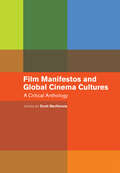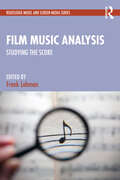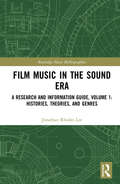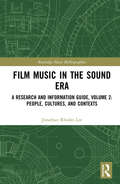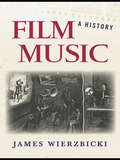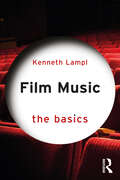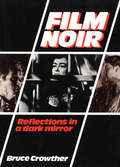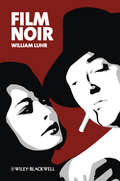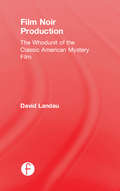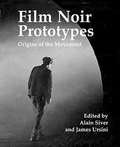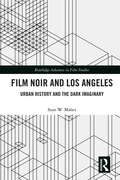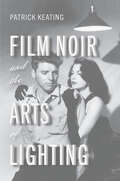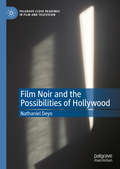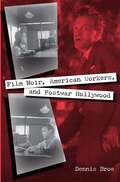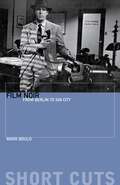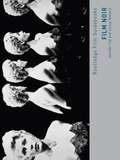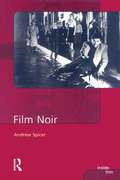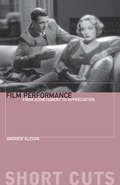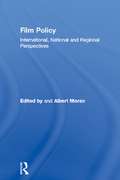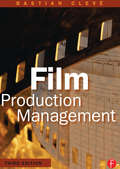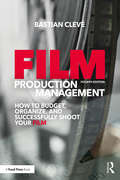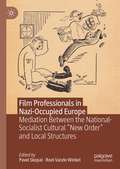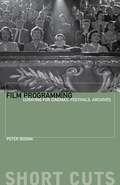- Table View
- List View
Film Manifestos and Global Cinema Cultures: A Critical Anthology
by Scott MackenzieFilm Manifestoes and Global Cinema Cultures is the first book to collect manifestoes from the global history of cinema, providing the first historical and theoretical account of the role played by film manifestos in filmmaking and film culture. Focussing equally on political and aesthetic manifestoes, Scott MacKenzie uncovers a neglected, yet nevertheless central history of the cinema, exploring a series of documents that postulate ways in which to re-imagine the cinema and, in the process, re-imagine the world.This volume collects the major European "waves" and figures (Eisenstein, Truffaut, Bergman, Free Cinema, Oberhausen, Dogme '95); Latin American Third Cinemas (Birri, Sanjinés, Espinosa, Solanas); radical art and the avant-garde (Buñuel, Brakhage, Deren, Mekas, Ono, Sanborn); and world cinemas (Iimura, Makhmalbaf, Sembene, Sen). It also contains previously untranslated manifestos co-written by figures including Bollaín, Debord, Hermosillo, Isou, Kieslowski, Painlevé, Straub, and many others. Thematic sections address documentary cinema, aesthetics, feminist and queer film cultures, pornography, film archives, Hollywood, and film and digital media. Also included are texts traditionally left out of the film manifestos canon, such as the Motion Picture Production Code and Pius XI's Vigilanti Cura, which nevertheless played a central role in film culture.
Film Music Analysis: Studying the Score (Routledge Music and Screen Media Series)
by Frank LehmanSince the establishment of film music studies, there has been a steady growth of serious analytical work on the film music repertoire. Film Music Analysis: Studying the Score offers the first collection of essays dedicated to the close investigation of musical structure and meaning in film music. Showcasing scholarship from a diverse and distinguished group of music theorists and musicologists, this book presents the many ways to inspect the inner workings of film music in a manner that is exciting and accessible to anyone curious about this music, regardless of their background in film or music theory.Each chapter takes as its focus one music-theoretical parameter and explores how that concept can be used to analyze and interpret film music. Covering theoretical concepts that range from familiar categories such as leitmotif and pitch structure to more cutting-edge ideas such as timbral associativity, topic theory, and metrical states, the book provides a toolkit with which to explore this captivatingly varied repertoire. With example analyses drawn from classic and contemporary films, Film Music Analysis: Studying the Score is a valuable teaching tool and an indispensable addition to the library of any lover of film and music.
Film Music in the Sound Era: A Research and Information Guide, Volume 1: Histories, Theories, and Genres (Routledge Music Bibliographies)
by Jonathan Rhodes LeeFilm Music in the Sound Era: A Research and Information Guide offers a comprehensive bibliography of scholarship on music in sound film (1927–2017). Thematically organized sections cover historical studies, studies of musicians and filmmakers, genre studies, theory and aesthetics, and other key aspects of film music studies. Broad coverage of works from around the globe, paired with robust indexes and thorough cross-referencing, make this research guide an invaluable tool for all scholars and students investigating the intersection of music and film. This guide is published in two volumes: Volume 1: Histories, Theories, and Genres covers overviews, historical surveys, theory and criticism, studies of film genres, and case studies of individual films. Volume 2: People, Cultures, and Contexts covers individual people, social and cultural studies, studies of musical genre, pedagogy, and the Industry. A complete index is included in each volume.
Film Music in the Sound Era: A Research and Information Guide, Volume 2: People, Cultures, and Contexts (Routledge Music Bibliographies)
by Jonathan Rhodes LeeFilm Music in the Sound Era: A Research and Information Guide offers a comprehensive bibliography of scholarship on music in sound film (1927–2017). Thematically organized sections cover historical studies, studies of musicians and filmmakers, genre studies, theory and aesthetics, and other key aspects of film music studies. Broad coverage of works from around the globe, paired with robust indexes and thorough cross-referencing, make this research guide an invaluable tool for all scholars and students investigating the intersection of music and film. This guide is published in two volumes: Volume 1: Histories, Theories, and Genres covers overviews, historical surveys, theory and criticism, studies of film genres, and case studies of individual films. Volume 2: People, Cultures, and Contexts covers individual people, social and cultural studies, studies of musical genre, pedagogy, and the Industry. A complete index is included in each volume.
Film Music: A History
by James WierzbickiFilm Music: A History explains the development of film music by considering large-scale aesthetic trends and structural developments alongside socioeconomic, technological, cultural, and philosophical circumstances. The book’s four large parts are given over to Music and the "Silent" Film (1894--1927), Music and the Early Sound Film (1895--1933), Music in the "Classical-Style" Hollywood Film (1933--1960), and Film Music in the Post-Classic Period (1958--2008). Whereas most treatments of the subject are simply chronicles of "great film scores" and their composers, this book offers a genuine history of film music in terms of societal changes and technological and economic developments within the film industry. Instead of celebrating film-music masterpieces, it deals—logically and thoroughly—with the complex ‘machine’ whose smooth running allowed those occasional masterpieces to happen and whose periodic adjustments prompted the large-scale twists and turns in film music’s path.
Film Music: The Basics (The Basics)
by Kenneth LamplA comprehensive introduction to film music, this book provides a concise and illuminating summary of the process of film scoring, as well as a succinct overview of the rich history of contemporary film music. Written in a non-technical style, this book begins by presenting a brief history of film music from the last 30 years, covering topics ranging from blockbuster franchises to indie film scores. It explores film music from around the world, including Bollywood and European Avant-garde cinema, and film music in animation, like Disney-Pixar and Japanese anime. It then offers a guide to the language of film music analysis, the creative process behind composing film music, and the use of current technology. The book champions diversity in the industry, with case studies and interviews from a range of active film composers, including: Pinar Toprak (Captain Marvel, 2019), Kris Bowers (Bridgerton, 2020), Natalie Holt (Loki, 2021), and Rachel Portman (Emma, 1996), Complete with a glossary of key terms and further reading, this book is an invaluable resource for all those beginning to study film music, as well as lifelong film music buffs seeking to update their understanding of film music.
Film Noir
by Bruce CrowtherWith the advent of the Second World War a new mood was discernible in film drama - an atmosphere of disillusion and a sense of foreboding, a dark quality that derived as much from the characters depicted as from the cinematographer's art. These films, among them such classics as Double Indemnity, The Woman in the Window, Touch of Evil and sunset Boulevard, emerged retrospectively as a genre in themselves when a French film critic referred to them collectively as film noir.Bruce Crowther looks into noir's literary origins (often in the novels of the so-called 'hard-boiled' school typified by Raymond Chandler, Dashiell Hammett and Cornell Woolrich), and at how the material translated to the screen, noting in particular influences from German expressionist films and the almost indispensable techniques of flashback and voice-over narration. He also assesses the contribution made by the players - by actors such as Robert Mitchum, Dick Powell, Alan Ladd and John Garfield and actresses such as Barbara Stanwyck, Lizabeth Scott, Joan Crawford and Gloria Grahame, together with a roll-call of supporting players whose screen presence could lend almost any film the noir imprimatur.Noir was in its heyday from 1945 to 1955, a time when paranoia and disillusion, anxiety and violence could be said to have been part of the fabric of American, and particularly Hollywood, society, yet its impact and its influence are with us still - in films as diverse as The French Connection, Chinatown and Body Heat. This Book commemorates a special period in film-making and a unique combination of talent resulting in a spectrum of films that are as welcome today on their small-screen airings as they were when first shown in cinema.
Film Noir
by William LuhrFilm Noir offers new perspectives on this highly popular and influential film genre, providing a useful overview of its historical evolution and the many critical debates over its stylistic elements.Brings together a range of perspectives on a topic that has been much discussed but remains notoriously ill-definedTraces the historical development of the genre, usefully exploring the relations between the films of the 1940s and 1950s that established the "noir" universe and the more recent films in which it has been frequently revivedEmploys a clear and intelligent writing style that makes this the perfect introduction to the genreOffers a thorough and engaging analysis of this popular area of film studies for students and scholarsPresents an in-depth analysis of six key films, each exemplifying important trends of film noir: Murder, My Sweet; Out of the Past; Kiss Me Deadly; The Long Goodbye; Chinatown; and Seven
Film Noir Production: The Whodunit of the Classic American Mystery Film
by David LandauDavid Landau’s Film Noir Production: The Whodunit of the Classic American Mystery Film is a book meant for those who like a good story, one the Noir Films always delivered, concentrating on the characters more than anything else. Readers will find in these pages many behind-the-scenes tales of the productions of certain hard-boiled film classics and the prime players involved in their creation, from Darryl Zanuck and Raymond Chandler to John Seitz and Billy Wilder. This book features: A clear understanding of how movies are actually made and all the creative artists that contribute, creating a better appreciation for the many talented artistic collaborators that worked in the Hollywood Studio System and who together created film noir. A behind-the-scenes look at the making of a classic film noir movie that typifies the chapter’s subject, allowing the reader to view that film in a new light and think about it from a new prospective. Appendices of suggested films to screen, film noir books for further reading, and downloadable files containing discussion points and class assignments for each chapter. An informative and conversational writing style, making the subject matter easy to digest and fun to read. This book is an indispensible companion text for anyone studying or interested in film noir, film history, the bygone days of the Hollywood film factories or how movies are actually made.
Film Noir Prototypes: Origins of the Movement
by Alain Silver James UrsiniFilm noir is one of the most enduring and popular genres in cinema. But it did not spring up spontaneously, fully formed. Rather, its origins can be traced to sources as varied as Victorian literature, German Expressionism, and American art and photography. In this comprehensive collection of essays that's packed with illustrations and artwork, a team of eminent scholars and film writers present thorough analyses of the influence of prototypes on the classic period of film noir. Some essays focus on particularly influential genres, such as the rogue cop film and "gothic" thrillers; while others discuss the choices of individual filmmakers, including John Ford and Alfred Hitchcock, in their most well-loved films. The editors and all of the featured contributors Sheri Chinen Biesen, Todd Erickson, Richard Edwards, Julie Grossman, Robert Miklitsch, Homer Pettey, Robert Porfirio, Tom Ryall, Marlisa Santos, Jesse Schlotterbeck, and Tony Williams are noted scholars in the field of film noir, most of whom have written book-length studies of their own. From the gangster and horror genres to social realism and Hitchcock's spy films of the 1930s, Film Noir Prototypes offers compelling accounts of the genre's influences.
Film Noir and Los Angeles: Urban History and the Dark Imaginary (Routledge Advances in Film Studies)
by Sean W. MaherThis book combines film studies with urban theory in a spatial exploration of twentieth century Los Angeles. Configured through the dark lens of noir, the author examines an alternate urban history of Los Angeles forged by the fictional modes of detective fiction, film noir and neo noir. Dark portrayals of the city are analyzed in Raymond Chandler’s crime fiction through to key films like Double Indemnity (1944) and The End of Violence (1997). By employing these fictional elements as the basis for historicising the city’s unrivalled urban form, the analysis demonstrates an innovative approach to urban historiography. Revealing some of the earliest tendencies of postmodern expression in Hollywood cinema, this book will be of great relevance to students and researchers working in the fields of film, literature, cultural and urban studies. It will also be of interest to scholars researching histories of Los Angeles and the American noir imagination.
Film Noir and the Arts of Lighting (Techniques of the Moving Image)
by Patrick KeatingMore than any other set of films from the classical era, the Hollywood film noir is known for its lighting: the cast shadows, the blinking street signs, the eyes sparkling in the darkness. Each effect is rich in symbolism, evoking a world of danger and doppelgangers. But what happens if we set aside the symbolism? This book offers a new account of film noir lighting, grounded in a larger theory of Hollywood cinematography as emotionally engaging storytelling. Above all, noir lighting is dynamic, switching from darkness to brightness and back again as characters change, locations shift, and fates unfold. Richly illustrated, Film Noir and the Arts of Lighting features in-depth analyses of eleven classic movies: The Asphalt Jungle, Sorry, Wrong Number, Odds against Tomorrow, The Letter, I Wake Up Screaming, Phantom Lady, Strangers on a Train, Sweet Smell of Success, Gaslight, Secret beyond the Door, and Touch of Evil.
Film Noir and the Possibilities of Hollywood (Palgrave Close Readings in Film and Television)
by Nathaniel DeyoBuilt around close readings of 11 noir films, this book seeks to refresh our understanding of “film noir” by returning to the films themselves. Pushing against totalizing or generalizing approaches, which may have the unintended effect of flattening out significant distinctions and differences between individual approaches, Film Noir and the Possibilities of Hollywood argues for the importance of staying attuned the varied and variegated formal, aesthetic and thematic strategies at work in individual films. By focusing on these strategies, the book invites readers to consider anew the enabling possibilities of Hollywood filmmaking in the studio era.
Film Noir and the Spaces of Modernity
by Edward DimendbergFilm noir remains one of the most enduring legacies of 1940s and '50s Hollywood. Populated by double-crossing, unsavory characters, this pioneering film style explored a shadow side of American life during a period of tremendous prosperity and optimism. Edward Dimendberg compellingly demonstrates how film noir is preoccupied with modernity--particularly the urban landscape. The originality of Dimendberg's approach lies in his examining these films in tandem with historical developments in architecture, city planning, and modern communications systems. He confirms that noir is not simply a reflection of modernity but a virtual continuation of the spaces of the metropolis. He convincingly shows that Hollywood's dark thrillers of the postwar decades were determined by the same forces that shaped the city itself. Exploring classic examples of film noir such as The Asphalt Jungle, Double Indemnity, Kiss Me Deadly, and The Naked City alongside many lesser-known works, Dimendberg masterfully interweaves film history and urban history while perceptively analyzing works by Raymond Chandler, Edward Hopper, Siegfried Kracauer, and Henri Lefebvre. A bold intervention in cultural studies and a major contribution to film history, Film Noir and the Spaces of Modernity will provoke debate by cinema scholars, urban historians, and students of modern culture--and will captivate admirers of a vital period in American cinema.
Film Noir, American Workers, and Postwar Hollywood: Film Noir, American Workers, And Postwar Hollywood (Working in the Americas)
by Dennis BroeFilm noir, which flourished in 1940s and 50s, reflected the struggles and sentiments of postwar America. Dennis Broe contends that the genre, with its emphasis on dark subject matter, paralleled the class conflict in labor and union movements that dominated the period.By following the evolution of film noir during the years following World War II, Broe illustrates how the noir figure represents labor as a whole. In the 1940s, both radicalized union members and protagonists of noir films were hunted and pursued by the law. Later, as labor unions achieve broad acceptance and respectability, the central noir figure shifts from fugitive criminal to law-abiding cop.Expanding his investigation into the Cold War and post-9/11 America, Broe extends his analysis of the ways film noir is intimately connected to labor history. A brilliant, interdisciplinary examination, this is a work that will appeal to a broad spectrum of readers.
Film Noir: From Berlin to Sin City
by Mark BouldFilm Noir explores the murky world of a genre responsible for many of film's most enduring images. Mark Bould discusses problems of definition and the often ambiguous nature of film noir and looks at modern films that could be called neo-noir. Iconic and enduring, film noir attracted great stars (Bogart, Bacall, Mitchum, Lancaster), many of the best directors of the era (Wilder, Lang, Preminger, Hawks, Siodmak, Welles) and this book is an indispensible guide to this popular genre.
Film Noir: From Berlin to Sin City (Short Cuts)
by Mark BouldFilm Noir explores the murky world of a genre responsible for many of film's most enduring images. Mark Bould discusses problems of definition and the often ambiguous nature of film noir and looks at modern films that could be called neo-noir. Iconic and enduring, film noir attracted great stars (Bogart, Bacall, Mitchum, Lancaster), many of the best directors of the era (Wilder, Lang, Preminger, Hawks, Siodmak, Welles) and this book is an indispensible guide to this popular genre.
Film Noir: Hard-boiled Modernity and the Cultures of Globalization (Routledge Film Guidebooks)
by Justus Nieland Jennifer FayThe term "film noir" still conjures images of a uniquely American malaise: hard-boiled detectives, fatal women, and the shadowy hells of urban life. But from its beginnings, film noir has been an international phenomenon, and its stylistic icons have migrated across the complex geo-political terrain of world cinema. This book traces film noir’s emergent connection to European cinema, its movement within a cosmopolitan culture of literary and cinematic translation, and its postwar consolidation in the US, Europe, Asia, the Middle East, and Latin America. The authors examine how film noir crosses national boundaries, speaks to diverse international audiences, and dramatizes local crimes and the crises of local spaces in the face of global phenomena like world-wide depression, war, political occupation, economic and cultural modernization, decolonization, and migration. This fresh study of film noir and global culture also discusses film noir’s heterogeneous style and revises important scholarly debates about this perpetually alluring genre.
Film Noir: On Classic Film Noir (Inside Film)
by Andrew SpicerFilm Noir is an overview of an often celebrated, but also contested, body of films. It discusses film noir as a cultural phenomenon whose history is more extensive and diverse than American black and white crime thrillers of the forties. An extended Background Chapter situates film noir within its cultural context, describing its origin in German Expressionism, French Poetic Realism and in developments within American genres, the gangster/crime thriller, horror and the Gothic romance and its possible relationship to changes in American society. Five chapters are devoted to ‘classic’ film noir (1940-59): chapters explore its contexts of production and reception, its visual style, and its narrative patterns and themes chapters on character types and star performances elucidate noir’s complex construction of gender with its weak, ambivalent males and predatory femmes fatales and also provide a detailed analysis of three noir auteurs, - Anthony Mann, Robert Siodmak and Fritz Lang Three chapters investigate ‘neo-noir’ and British film noir: chapters trace the complex evolution of ‘neo-noir’ in American cinema, from the modernist critiques of Night Moves and Taxi Driver, to the postmodern hybridity of contemporary noir including Seven, Pulp Fiction and Memento the final chapter surveys the development of British film noir, a significant and virtually unknown cinema, stretching from the thirties to Mike Hodges’ Croupier Films discussed include both little known examples and seminal works such as Double Indemnity, Scarlet Street, Kiss Me Deadly and Touch of Evil. A final section provides a guide to further reading, an extensive bibliography and a list of over 500 films referred to in the text. Lucidly written, Film Noir is an accessible, informative and stimulating introduction that will have a broad appeal to undergraduates, cinéastes, film teachers and researchers.
Film Performance: From Achievement to Appreciation (Short Cuts)
by Andrew KlevanPerformers make a crucial contribution to the achievement of narrative films. By moving through exemplary sequences, this book closely follows the movement and behaviour of screen performers – Charlie Chaplin, Laurel and Hardy, Cary Grant, Katherine Hepburn, Marlene Dietrich, Barbara Stanwyck, Richard Widmark – and by emphasising their relationship to other aspects of film style – camera, location and plot – it develops accounts that are specific and involved. This study concentrates on films from the ‘Golden Age’ of Hollywood and moment-by-moment descriptions enable fresh interpretations to emerge and evolve. These reveal the significance and intensity of a performer’s engagement with the world of a film.
Film Policy: International, National and Regional Perspectives (Culture: Policy and Politics)
by Albert MoranFilm Policy is the first comprehensive overview of the workings of the international film industry. The authors examine film cultures and film policy across the world, explaining why Hollywood cinema dominates the global film market, and the effects of the rise of television and video on the international industry. In a series of case studies drawn from North America, Europe, Latin America, Asia and Australia, the authors explore the relationship between Hollywood cinema product and national film cultures, and trace the development of international and national film policies, looking at issues of financing, regulation, protectionism and censorship.
Film Production Management
by Bastian CleveFilm Production Management will tell you in step-by-step detail how to produce a screenplay and get it onto the big screen. Whether you are an aspiring or seasoned film professional, this book will be an indispensable resource for you on a day-to-day basis. This updated edition remains true to the practical, hands-on approach that has made previous editions so successful, and has been updated with revised forms, permits, and budgets applicable to all productions; contains important information on standards and typical processes and practices; includes the latest information available on technological advances such as digital FX; and discusses the impact of the Internet on filmmaking. Film production professionals at all levels of experience will benefit from the information in this handbook to film production management.
Film Production Management: How to Budget, Organize and Successfully Shoot your Film
by Bastian CleveThis new and updated fourth edition of Film Production Management provides a step-by-step guide on how to budget, organize, and successfully shoot a film and get it onto the big screen. Whether you are a film student or film production professional just getting started in the industry, this book is an indispensable resource for day-to-day business on the set. Written by veteran filmmaker Bastian Clevé, this book will teach you how to: Break down a screenplay Organize a shooting schedule Create a realistic budget Find and secure locations Network with agents to find actors Hire a crew and communicate effectively with unions The new edition features updated information on contracts, permits, and insurance; special tips for low-budget filmmaking; new information on digital workflows and production software; advice on green production practices; and expanded coverage of the role of the line producer.
Film Professionals in Nazi-Occupied Europe: Mediation Between the National-Socialist Cultural “New Order” and Local Structures
by Roel Vande Winkel Pavel SkopalThis book analyses the film industries and cinema cultures of Nazi-occupied countries (1939-1945) from the point of view of individuals: local captains of industry, cinema managers, those working for film studios and officials authorized to navigate film policy. The book considers these people from a historical perspective, taking into account their career before the occupation and, where relevant, pays attention to their post-war lives. The perspectives of these historical agents” contributes to an understanding of how top-down orders and haphazard signals from the occupying administration were moulded, adjusted and distorted in the process of their translation and implementation. This edited collection offers a more dynamic and less deterministic approach to research on the international expansion of Third-Reich cinema in World War Two; an approach that strives to balance the role of individual agency with the structural determinants. The case studies presented in this book cover the territories of Belgium, Czechoslovakia, France, the Netherlands, Norway, Poland and the Soviet Union.
Film Programming
by Peter BosmaThis book explores artistic choices in the field of cinema exhibition, focusing on film theatres, film festivals, and film archives, setting the various issues of film curating in their international context. The availability of artistic and commercial film has increased overwhelmingly as a result of the digitization of the infrastructure of distribution and exhibition; in this overflow of supply a reasoned and well-grounded selection is necessary more than ever. The conventional structures of the film trade are in a process of transformation and, in the digital age, supply and demand can meet without the intervention of traditional gatekeepers; everybody can be a film curator, in a passive or active way. This volume addresses three kinds of readers: those who want to become film curators themselves, or do research of the phenomenon of film curating, and those who are critical cinema visitors who want to investigate the story behind the process of selection of the available film supply and the way to present these films.
